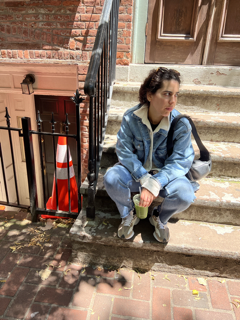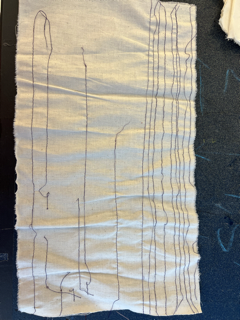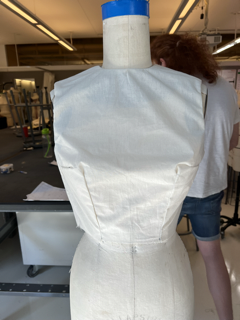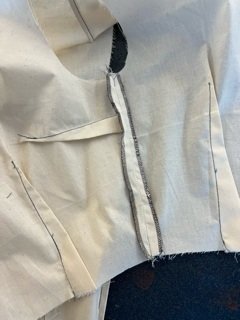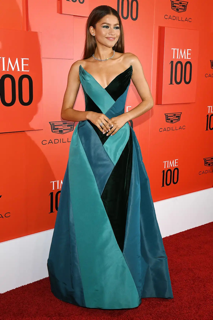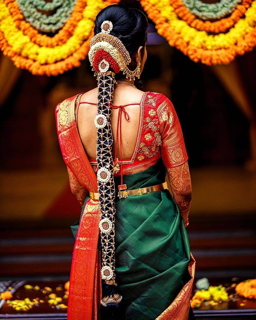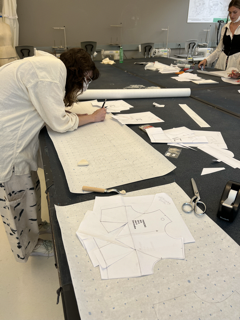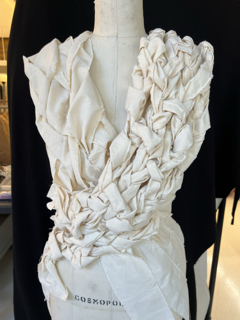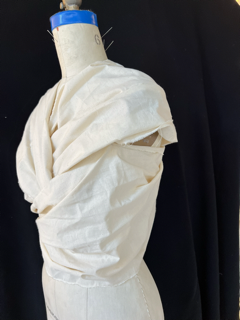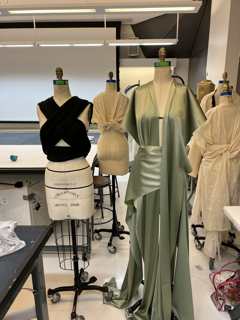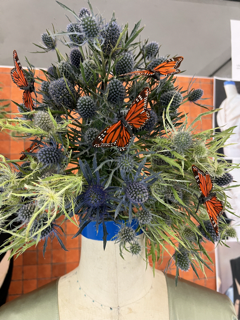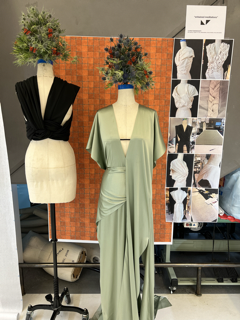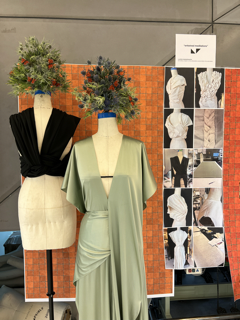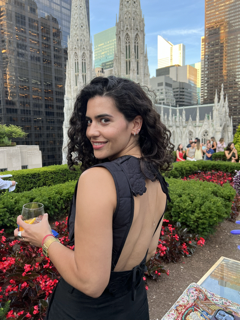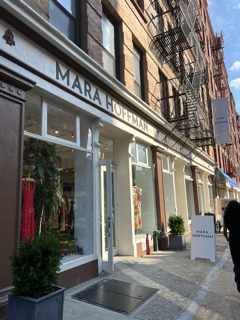Parsons Summer 2022 Intensive Course: Fashion Construction
When I saw there was an opportunity to spend 3 weeks in NYC to study fashion where some of my favourite designers went, I signed right up.
Here’s a recap of my time studying fashion construction this past summer (better late than never, right?).
Arrived in rough shape the morning after my bestie’s amazing wedding.
Our building, home sweet home for a few weeks.
Evidence I was, in fact, in NYC.
Week 1: Foundations & Research
Construction Foundations
We started by digging into what’s what in construction techniques. We learned to differentiate between the different seam types and practiced sewing techniques on machines and by hand. Learning how to use the industrial machines was also a big part of the first week - threading them is a process but, after a few days, the flow got a lot easier.
To bring together what we learned, each student constructed a ‘Frankenstein’ sample bodice that used different seams, facing, a zipper closure, and darts.
Sewing machine trials and tribulations.
Outside of the bodice.
Inside seams on the bodice - lots of ironing involved.
Craft Research
Our instructor introduced other construction techniques beyond sewing in the form of craft: braiding, needlepoint, weaving, etc. Each student chose a craft to focus on and research more about. The research process was a lot different and more freeform than my previous academic endeavours where, honestly, most time was spent worrying about MLA formatting. This research was about history, cultural context, practical applications, tactile use cases, and finding inspiration - references required, but no excessive formal formatting.
I chose braiding and began learning more about the rich social history of the craft. I learned it is a polygenetic craft (universal across cultures) and has been used to strengthen materials, protective measures, and for aesthetic beauty. It’s been done using a wide variety of available materials and has often been a social art, shared between people rather than done in isolation. It has a rich and varied history connecting it to construction, military, identity, community, and exists on a large continuum: spanning simple to complex designs, manual to industrial production, and rural and urban relevance.
Zendaya in Bob Mackie, hello.
Braided hair with jewelery.
Week 2: Exploration & Final Concepts
Pattern Making
To start week 2, we dug into the fundamentals of pattern making by learning the differences in dart manipulations, practicing drawing different bodice types, and understanding how to recognize different garment types. It reminded me a lot of geometry class in elementary school when you had to identify 3D shapes (polyhedrons?) from flat nets - but way more challenging. Seeing complex garments deconstructed into flat shapes was a new way to conceptualize clothing and very enlightening. We learned about notch marks and grain lines which, put simply, symbols that instruct the team constructing the garment on what direction and how many pieces should be cut from the piece, and how and where it fits with the other pieces.
Probably the most frustrating part of the course was experimental pattern making. We drew abstract shapes, added darts, pleats, strips, and angles where ever they felt right. From there, the pattern pieces were cut from muslin and sewn, helping us grasp how volume, shape, and different cuts had an impact on the quality of the garment. We all felt eager to get started on the ‘real’ garments we wanted to make and complained a whole lot - but it was a fruitful exercise to apply what we had learned and stay grounded in the process rather than going straight to final product.
Anna being a legend, drafting and moving darts.
Mystery pattern with strips to integrate braiding.
Craft Exploration
This week we also began experimenting with our chosen crafts in a variety of materials. I grabbed ribbons, scrap fabrics, and ropes and began braiding away: twists, three strands, four strands, 8 strands, in consistent and more varied patterns, seeing what stuck and what simply did not work. I played with proportion - using very tiny ropes to make what ended up looking like a delicate, lace-like pattern and wide strips of muslin to cover more of the body.
These samples were then used, along with the mystery patterns mentioned above, to start draping on the dress forms. This process was super fun, playful, and informative. As someone who often goes straight to final concepts, being forced to go through a more generative process and spend more time in the experimental phase was fruitful. It led me to my final concept: adapting the ‘infinity braid’ I had made from large strips of fabric into a top and gown.
Smaller scale braids.
Using braid as a seam.
Draping samples on dress form.
Week 3: Final Garment(s) & Presentation
Final Garment Construction
Since I landed on a design that was three strips of fabric braided around the body, I wasn’t going to spend any time pattern making and decided to challenge myself to make two final garments instead of one: a top and gown iteration of the same concept.
The original drape inspiration was a top. Figuring out the right closure and finding a material that was comfortable, while offering enough stretch to get on and off, was a challenge. I landed on a black stretch modal fabric (I love wearing modal) for the top and a pale green stretch silk charmeuse for the gown. Snap closures ended up being the most discreet and effective for both garments.
Original drape that led to final design concept.
Adapting design into a dress and trying to figure out which strip is which.
Work in progress on the top.
I was encouraged to cut and surge the silk charmeuse but decided it would not look good to have edges finished that way. I cheated, with the help of my professor, who asked his friend Cyril Verdivainne for help baby hemming, a skill far beyond my beginner sewing level. From there, I hand sewed the seams in strategic areas for more coverage, added snaps for closures at the side, and started setting my sights on the final presentation.
Final garments with toiles visible behind.
Open Studio
We had access to a large scale printer and each got to claim an area of the classroom to set up our final garments and display our process work.
I took inspiration from Spain and the Mara Hoffman flagship store and wanted to incorporate terracotta tiles, a rich brown orange that would set off the green and black. I also wanted to incorporate some plants, integrating my love of gardening and flowers with my love of design and fashion. I decided to lean into a retail styling, claiming a little area of the classroom and hanging a large tile poster and ‘reworking’ the dress forms to add a bit of surrealism. I picked up some foam and monarch butterflies at Michaels and got thistle (the cool blue tone playing nicely with the green silk dress) at my bodega the morning of the presentation to construct new mannequin ‘heads’.
Gathering materials.
Detail of mannequin ‘head’.
Having never presented any of my visual creative work, it ended up being a huge learning curve seeing how other students (who go to Parsons full time and had studied longer) displayed their work: lots had taken time to have a photoshoot with models, with large hanging portraits showing the garments in motion for a more editorial effect. All classses that were running at the time participated, beyond the fashion department, so it was really inspiring to see the graphic design, product design, animation, gaming and more.
Overall, I was really happy with the feedback I received and caught some attendees and other students taking photos of my work. While I can’t claim expert craftsmanship (and, honestly, determined that construction is better left to a professional while I guide vision and design), I was proud of how the whole package came together having no other formal training. My professor said I was a ‘renaissance woman’ and said the top had a Balenciaga air to it (Cristobal, not Demna, we hope), and another professor, former employee of Prada, took photos and said the styling reminded her of the sprouted Loewe collection. I’ll be keeping those thoughts in my back pocket next time I doubt my instincts.
Final presentation.
See my full process here.
(File size greatly reduced.)
Reflections
Garments
If I were to refine the garments, I would have added a more involved closure for the top: a full ‘break’ in the back so that the garment could be taken on and off more easily than pulling it overhead. I would also search more for a richer black material (Norma Kamali’s black elephant pants come to mind for a similar balance of stretch, drape, and structure).
For the dress, I would also revisit the experience getting it on and off - I think so much of a garment’s appeal and longevity has to do with how it is experienced by the person wearing it, so making this more streamlined and secure would be a priority.
After seeing how other full-time fashion students demonstrated their work, I would have put more intention behind shooting my processes and incorporated more large scale photography into the final presentation.
Top (back) detail.
Back of top, front of dress.
Love of my life and fruits of my labour.
Experience
It was amazing to spend time with other creatives and be back in a school setting (once a nerd, always a nerd). I was right in between the age of the teacher and most of the other students and learning from people from different generations and with different aesthetics was so refreshing. It was fun exploring the other final projects with friends and having my husband come and see my work. As a copywriter, I take on the voice of my clients and my process is internal and personal and my final products are quietly shipped to clients. It was nice to be forward-facing and having something tangible to show my own point of view.
Not to mention having an extended stay in NYC was a wonderful way to find a flow within the city and understand its rhythms. My husband and I settled into an AirBnB in West Village and it was qUiRkY (see: shower in kitchen) but amazing. I got into a morning groove with the bodega downstairs and thrived walking back and forth from school each day, soaking up the street fashion, becoming part of the fabric of the city, and planning evening detours, boutique visits, museum, seeing local friends, and enjoying park hang outs.
Mood, making my Project Runway dreams come true.
Tiffany event with a whole different NYC crowd (thanks, Torin)!
Mara Hoffman store, a retail experience highlight (along with Bode, The Row, and Dover Street Market).
The trip was particularly special for us, as the last week we were there, we learned we were expecting our first baby! A whole new adventure was beginning before the one we were on was even over.
Blessings all around.
